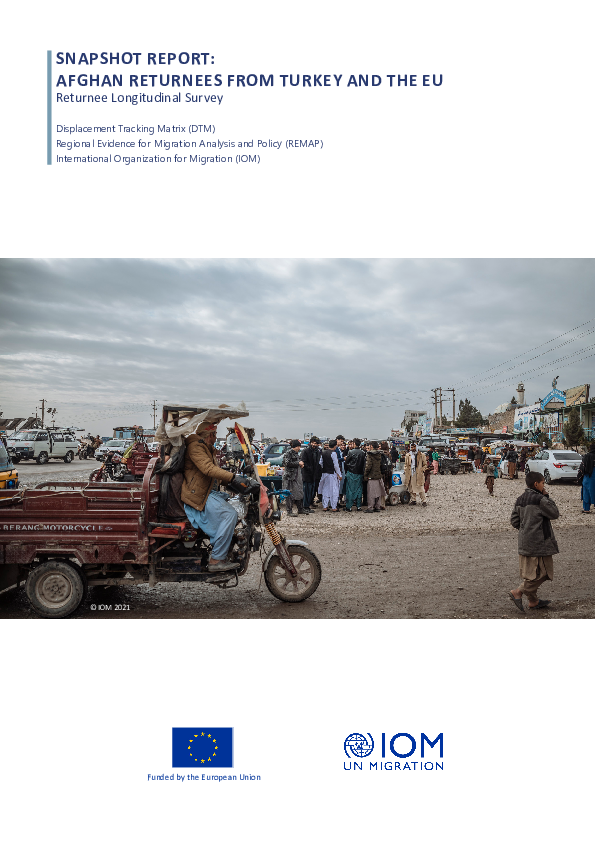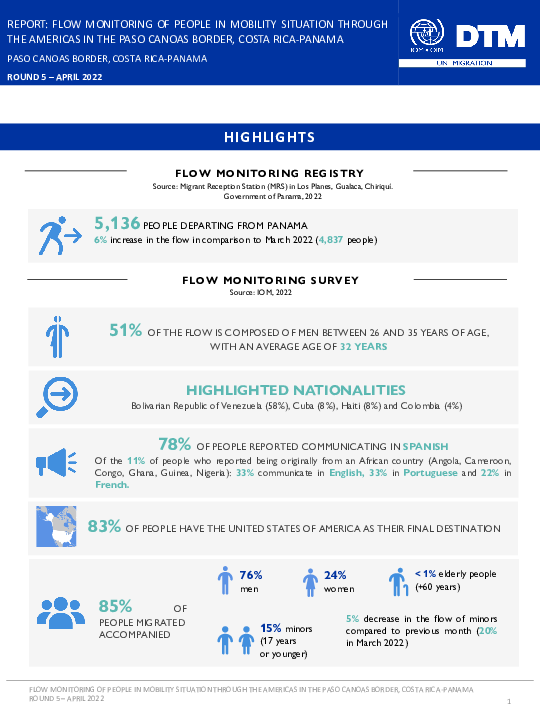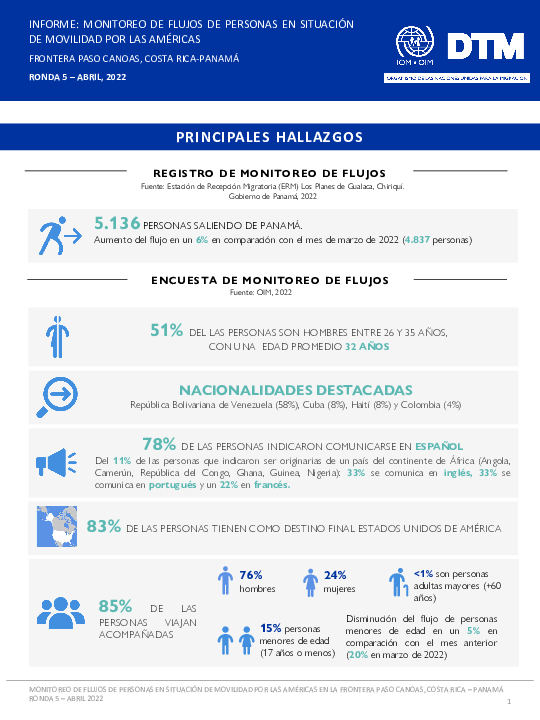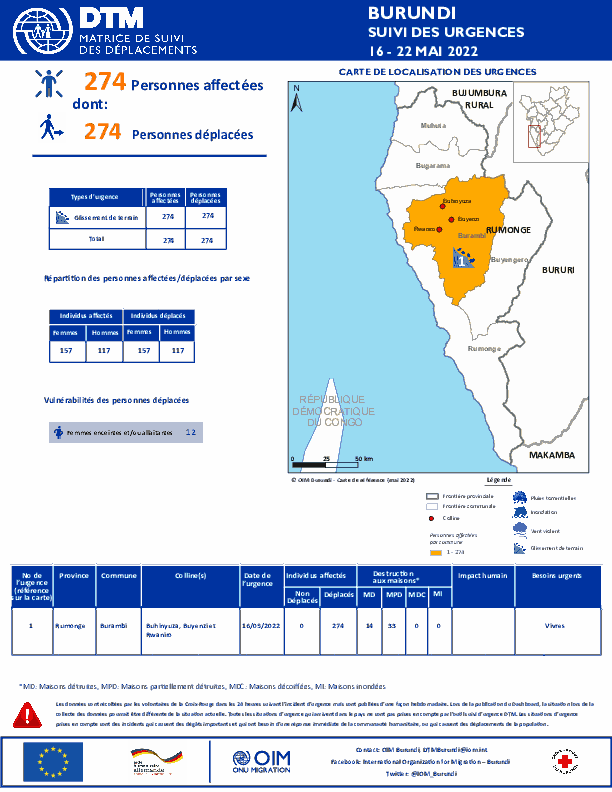-
Countries
-
Data and Analysis
-
Special Focus
-
Crisis Responses
Flow Monitoring is a component of DTM and it is used to track population movements inside a country, within a region or across regions.
The dataset includes: - monthly and daily figures on arrivals by sea and by land to Europe (Bulgaria, Cyprus, Greece, Italy, Malta, Spain) - monthly and daily figures on transits along the Western Balkan region (Albania, Bosnia and Herzegovina, Croatia, Montenegro, North Macedonia, Romania, Slovenia, Serbia, Kosovo*) - figures on reported country of origin of arrivals and transits - figures on reported migrant presence in reception centers.
Population Groups
Survey Methodology
Unit of Analysis Or Observation
Type of Survey or Assessment
Keywords

Contact
DTMcovid19@iom.int
Language
English
Location
Global
Period Covered
May 16 2022
May 23 2022
Activity
- Other
The DTM Global Mobility Restrictions Overview provides updates on international air travel restrictions and conditions for authorized entry. This overview aims to understand how COVID-19 has impacted human mobility, detailing how global and regional trends in air travel measures have evolved since COVID-19 was declared a global pandemic in March 2020. The data presented focuses on the changes in public health-related immigration and border management measures. It provides information intended to support IOM missions and partners in targeted response planning and advocacy for vulnerable populations who may be affected by changes in global mobility.

Contact
DTMcovid19@iom.int
Language
English
Location
Global
Period Covered
May 09 2022
May 16 2022
Activity
- Other
The DTM Global Mobility Restrictions Overview provides updates on international air travel restrictions and conditions for authorized entry. This overview aims to understand how COVID-19 has impacted human mobility, detailing how global and regional trends in air travel measures have evolved since COVID-19 was declared a global pandemic in March 2020. The data presented focuses on the changes in public health-related immigration and border management measures. It provides information intended to support IOM missions and partners in targeted response planning and advocacy for vulnerable populations who may be affected by changes in global mobility.

Contact
DTMAfghanistan@iom.int
Language
English
Location
Afghanistan
Period Covered
May 01 2021
Aug 31 2021
Activity
- Survey
- Return Intention
This report is the result of the first round of data collection that took place from May to August 2021 with Afghan migrants who returned from Turkey and the EU in 2018, 2019, 2020 and 2021 through IOM’s Assisted Voluntary Return and Reintegration (AVRR) and Stabilisation, Reintegration and Resilience (SRR) programmes. During the data collection period, 998 respondents were interviewed in person or over the phone across 102 districts in 17 provinces.
This report is divided into three main sections. The first section summarises the key findings in this report. The second section starts with a description of the methodology and includes the research method, sampling information and limitations. The third section presents the analysis of the data that was collected between May and August 2021. The analysis chapter is further subdivided into eight thematic sections. The first subsection covers the demographics and socio-economic profiles of the return migrants. This is followed by a subsection on the employment situation, occupational sector and income and debt status of the returnees (prior to migration; in Turkey or the EU and in Round 1, which took place from May to August 2021). The third subsection explores the reasons for migration. The fourth subsection examines the migration journey, including the reasons for migrating to Turkey or the EU. The following subsection dives deeper into the reasons for return and then an additional subsection goes into the challenges that returnees experience after returning to Afghanistan. Finally, the last two subsections examine prior migration experiences and re-migration intentions.

Contact
Angelica Madrigal amadrigal@iom.int
Language
English
Location
Costa Rica
Period Covered
Apr 01 2022
Apr 30 2022
Activity
- Flow Monitoring Survey
- Flow Monitoring
- Mobility Tracking
- Baseline Assessment
In the framework of the COVID-19 emergency, since March 19, 2020, the Government of Costa Rica has kept its land border with Panama closed for the Controlled Flow Binational Operation, which sought an orderly and safe migration of migrants moving through the Americas.
From August 2021 to March 2022, the Government of Panama reports the entry into Panama of 102,122 migrants: Haiti (56%), Cuba (11%), Brazil (7%), Bolivarian Republic of Venezuela (6%), Chile (6%) among other countries in South America, Africa and Asia (13%).
In Costa Rica, during 2022, a steady increase in the number of migrants of this migration flow has been identified (as of April 2022 it has increased by 30% compared to December 2021, when the monitoring of flows in Costa Rica began). According to data from the General Directorate of Migration and Aliens (DGME), during May 2021 and February 2022, 5,426 rejections were reported in Paso Canoas.
In Costa Rica, many vulnerabilities are perceived: pregnant women, children under five years of age, emotional exhaustion caused by stress, anguish and frustration. In addition, the main needs detected are associated with access to food, shelter, medical assistance and safety during their migration journey.

Contact
Angelica Madrigal amadrigal@iom.int
Language
Spanish
Location
Costa Rica
Period Covered
Apr 01 2022
Apr 30 2022
Activity
- Flow Monitoring Survey
- Flow Monitoring
- Mobility Tracking
- Baseline Assessment
En el marco de la emergencia por la COVID-19, desde el 19 de marzo del 2020, el Gobierno de Costa Rica mantiene cerrada su frontera terrestre con Panamá para la Operación Binacional Flujo Controlado, la cual procuraba una migración ordenada y segura de personas migrantes en situación de movilidad por América.
Desde agosto de 2021 hasta marzo de 2022, el Gobierno de Panamá reporta el ingreso a Panamá de 102.122 personas migrantes: Haití (56%), Cuba (11%), Brasil (7%), República Bolivariana de Venezuela (6%), Chile (6%), entre otros países del Sur de América, África y Asia (13%).
En Costa Rica, durante el 2022, se ha identificado un aumento constante en la cantidad de personas migrantes de este flujo migratorio (a abril de 2022 ha aumentado en un 30% en comparación con diciembre, 2021, cuando inició el monitoreo de flujos en Costa Rica). Además, de acuerdo con datos de la Dirección General de Migración y Extranjería (DGME), durante mayo de 2021 y febrero de 2022 se han realizaron 5.426 rechazos en Paso Canoas.
En Costa Rica se perciben muchas vulnerabilidades: mujeres embarazadas, niños y niñas menores de cinco años, desgaste emocional ocasionado por estrés, angustia y frustración. Además, las principales necesidades detectadas se asocian con el acceso a alimento, alojamiento, asistencia médica y seguridad en su trayecto.

Contact
DTM Mali, DTMMali@iom.int
Language
French
Location
Mali
Period Covered
Jan 01 2022
Mar 31 2022
Activity
- Survey
- Flow Monitoring Survey
- Flow Monitoring
Le rapport présente les principaux résultats des enquêtes individuelles effectuées par la DTM auprès de migrants transitant par les points de suivi de flux (FMP) du Mali au cours du premier trimestre de l’année 2022.
Les résultats des enquêtes FMS réalisées témoignent du fait que le Mali soit l’une des principales routes empruntées par les migrants en Afrique de l’Ouest. En effet, la diversité des nationalités observées (18 nationalités), des routes empruntées, des pays de provenance et de destination, démontrent la place prépondérante qu’occupe le Mali dans les mobilités en Afrique de l’Ouest et du Centre.
Il ressort par ailleurs de ces analyses que les migrants sont majoritairement des hommes célibataires, des jeunes âgés entre 20 et 30 ans voyageant principalement pour des raisons économiques. Spécifiquement, ils sont à la recherche d’opportunités de travail soit à l’intérieur de la région, soit en Afrique du Nord ou espérant rejoindre l’Europe.

Contact
DTM Mali, DTMMali@iom.int
Language
French
Location
Mali
Period Covered
Apr 01 2022
Apr 30 2022
Activity
- Mobility Tracking
- Baseline Assessment
Au cours des quatre premiers mois de l’année 2022, dans un contexte marqué par l’insécurité et la fermeture des frontières terrestres et aériennes entre le Mali et les pays de la Communauté économique des Etats de l’Afrique de l’Ouest (CEDEAO), des combats et attaques sporadiques se sont poursuivis dans plusieurs localités du pays occasionnant des déplacements internes de populations civiles dans le Nord et dans le Centre du pays. Le caractère violent des conflits a provoqué d’importants déplacements de populations à l’intérieur du territoire malien et dans les communes frontalières entre le Burkina Faso et le Niger, avec des méthodes de mouvements très complexes à suivre. Des déplacements de courte durée ont continué à être signalés dans différentes régions du pays. L’amélioration significative des conditions de sécurité dans certaines localités a permis à de nombreuses personnes déplacées internes (PDI), vivant toujours dans des conditions extrêmes à regagner leurs foyers au Centre et au Nord du pays, mais de nombreux obstacles persistent, les empêchant de trouver des solutions durables à leur déplacement.
Suite aux violences constatées dans certaines localités des Régions de Ménaka, Tombouctou, Gao, Mopti et Ségou, le nombre de PDI est en effet passé de 350 110 de décembre 2021 à 370 548 personnes en avril 2022. Cependant, en avril, dans la région de Ségou, il est noté une baisse considérable (environ 37%) du nombre total de PDI suite à des retours observés dans les zones d’origine. L’accès à la terre cultivable et la sécurisation de certaines localités d’origine notamment dans le cercle de Niono, ont été les principales raisons de retours évoquées par certains ménages déplacés dans la région de Ségou.
Contact
DTM Yemen, iomyemendtm@iom.int
Location
Yemen
Activity
- Mobility Tracking
- Event Tracking
Period Covered
May 15 2022 -May 21 2022
From 1 January to 21 May 2022, IOM Yemen DTM tracked 5,939 households (HH) (35,634 Individuals) who experienced displacement at least once.
Between 15 and 21 May 2022, IOM Yemen DTM tracked 95 households (570 individuals) displaced at least once. The majority of people moved into/within the following governorates and districts:
• Al Hodeidah (25 HHs) – Hays (14 HHs), Al Khukhah (11 HHs) districts. All displacements in the governorate were internal.
• Marib (23 HHs) – Marib City (21 HHs), Marib (2 HHs) districts. Most displacements in the governorate originated from Ibb and Al Jawf.
• Ad Dali (21 HHs) – Qatabah (11 HHs), Ad Dali (10 HHs) districts. Most displacements in the governorate originated from Ad Dali and Ibb.
The majority of people moved from the following governorates and districts:
• Al Hodeidah (41 HHs) – Hays (30 HHs), Al Khukhah (4 HHs), Al Jarrahi (3 HHs) districts.
• Ibb (13 HHs) – Al Qafr (3 HHs), Al Makhadir (3 HHs), Yarim (2 HHs) districts.
• Ad Dali (13 HHs) – Qatabah (9 HHs), Al Husha (4 HHs) districts.
Population Groups
Survey Methodology
Unit of Analysis Or Observation
Type of Survey or Assessment
Keywords
Geographical Scope
Administrative boundaries with available data
The current dataset covers the following administrative boundaries

